
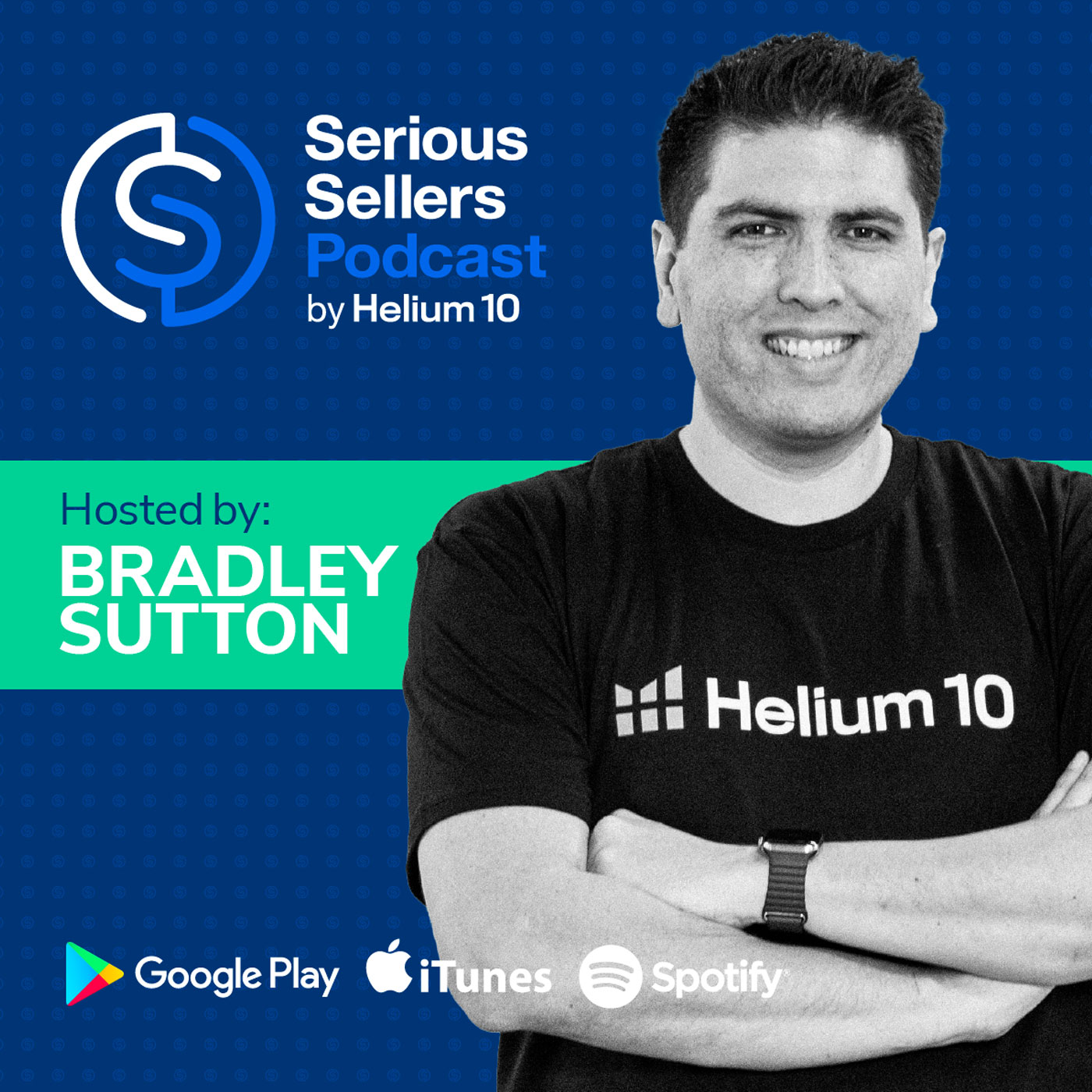
4.1M
Downloads
924
Episodes
Are you an Amazon FBA, TikTok Shop, Walmart, or Ecommerce Seller, or someone interested in becoming one? The Serious Sellers Podcast by Helium 10 is an unscripted, unrehearsed, BS-free, organic conversation between host Bradley Sutton, and real life sellers and thought leaders in the ecommerce world, where they share the top strategies that will help sellers of all levels succeed. In addition, every week there is an episode of the ”Weekly Buzz” which gives a rundown of the latest news in the Ecommerce world. ► Instagram: instagram.com/serioussellerspodcast ► Free Amazon Seller Chrome Extension: https://h10.me/extension ► Sign Up For Helium 10: https://h10.me/signup (Use SSP10 To Save 10% For Life) ► Learn How To Sell on Amazon: https://h10.me/ft ► Watch The Podcasts On Youtube: youtube.com/@Helium10/videos
Episodes
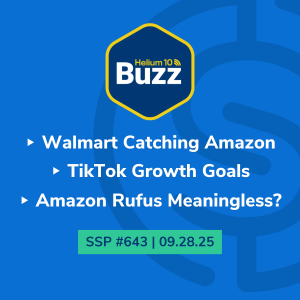
Wednesday Feb 26, 2025
#643 - Walmart catching Amazon & TikTok Growth Goals | Weekly Buzz 2/26/25
Wednesday Feb 26, 2025
Wednesday Feb 26, 2025
A change for the Serious Sellers Podcast, Walmart has caught up fast to Amazon in something, and Is Amazon Rufus meaningless? These and more buzzing news on this episode!
► Instagram: instagram.com/serioussellerspodcast
► Free Amazon Seller Chrome Extension: https://h10.me/extension
► Sign Up For Helium 10: https://h10.me/signup (Use SSP10 To Save 10% For Life)
► Learn How To Sell on Amazon: https://h10.me/ft
► Watch The Podcasts On Youtube: youtube.com/@Helium10/videos
We’re back with another episode of the Weekly Buzz with Helium 10’s VP of Education and Strategy, Bradley Sutton. Every week, we cover the latest breaking news in the Amazon, Walmart, and E-commerce space, talk about Helium 10’s newest features, and provide a training tip for the week for serious sellers of any level.
Walmart CEO delivers alarming news for Amazon
https://www.msn.com/en-us/money/companies/walmart-ceo-delivers-alarming-news-for-amazon/ar-AA1zHNTw?ocid=finance-verthp-feeds
Amazon Alexa event live - Alexa Plus officially announced, with more news still to come
https://www.techradar.com/news/live/amazon-alexa-event-2025-live
TikTok Shop eyes 100% growth in 2025
https://jingdaily.com/posts/tiktok-shop-eyes-100-growth-in-2025-amid-us-uncertainty
Is Amazon on course to upend LTL industry?
https://www.freightwaves.com/news/is-amazon-on-course-to-upend-ltl-industry
Online marketplace Temu allowing Canadian businesses to sell through platform
https://ca.finance.yahoo.com/news/online-marketplace-temu-allowing-canadian-151954793.html
Launching sponsored ads for authors: India, Japan, Mexico, Netherlands
https://advertising.amazon.com/en-us/resources/whats-new/sponsored-products-and-sponsored-brands-ads-expansion/
We also take a closer look at the advanced features in Black Box and Helium 10 Ads, emphasizing new strategies for keyword harvesting that allow you to fine-tune your targeting criteria and adjust cost per click to boost your campaigns. Learn how utilizing these features can maximize your impressions and improve efficiency. Moreover, discover how Helium 10's Alerts tool can help you identify opportunities to save on fulfillment costs by making small adjustments to product dimensions. These tweaks could potentially save or earn you significant extra profit over the year.
This episode also explores the controversial Amazon Rufus AI and its impact on Amazon listing optimization. While Rufus shows potential, it has limitations, particularly in generating accurate search suggestions for niche products and identifying deals. We highlight the importance of ensuring that product descriptions are comprehensive to improve customer experience and sales. Listen in as we analyze Rufus' keyword suggestions, examining their current relevance and potential future significance as more users adopt these recommendations. Thanks for tuning in and we’ll see you next week!
In this episode of the Weekly Buzz by Helium 10, Bradley covers:
- 00:42 - SSP Schedule Change
- 02:47 - Walmart Same Day Delivery
- 04:36 - New Amazon Alexa?
- 06:07 - TikTok Growth
- 06:57 - Amazon LTL?
- 09:43 - Temu For Canadians
- 10:30 - PPC For Authors
- 11:06 - Helium 10 New Feature Alerts
- 15:22 - Strategy of the Week: Size Tier Alerts
- 18:55 - Hot Take Of The Week: Rufus is Meaningless?
Enjoy this episode? Be sure to check out our previous episodes for even more content to propel you to Amazon FBA Seller success! And don’t forget to “Like” our Facebook page and subscribe to the podcast on iTunes, Spotify, or wherever you listen to our podcast.
Get snippets from all episodes by following us on Instagram at @SeriousSellersPodcast
Want to absolutely start crushing it on Amazon? Here are few carefully curated resources to get you started:
- Freedom Ticket: Taught by Amazon thought leader Kevin King, get A-Z Amazon strategies and techniques for establishing and solidifying your business.
- Helium 10: 30+ software tools to boost your entire sales pipeline from product research to customer communication and Amazon refund automation. Make running a successful Amazon or Walmart business easier with better data and insights. See what our customers have to say.
- Helium 10 Chrome Extension: Verify your Amazon product idea and validate how lucrative it can be with over a dozen data metrics and profitability estimation.
SellerTrademarks.com: Trademarks are vital for protecting your Amazon brand from hijackers, and sellertrademarks.com provides a streamlined process for helping you get one.

Saturday Feb 22, 2025
#642 - How to Make a Podcast
Saturday Feb 22, 2025
Saturday Feb 22, 2025
In this episode, learn how to create a podcast to grow your brand and community. Discover the steps that helped the Serious Sellers Podcast by Helium 10 reach 5M+ downloads.
► Instagram: instagram.com/serioussellerspodcast
► Free Amazon Seller Chrome Extension: https://h10.me/extension
► Sign Up For Helium 10: https://h10.me/signup (Use SSP10 To Save 10% For Life)
► Learn How To Sell on Amazon: https://h10.me/ft
► Watch The Podcasts On YouTube: youtube.com/@Helium10/videos
What if launching a podcast could be the game-changer you need for your personal or E-commerce business brand? In this episode, we explore the transformative power of podcasting, sharing insights from over seven years of experience and success stories like Helium 10, which started with the AM/PM podcast before evolving into an e-commerce software powerhouse. We reveal how podcasts can build vibrant communities around niche interests, from pet care to other e-commerce topics, turning listeners into brand advocates and opening up new revenue streams.
Dive into the essentials of crafting a podcast strategy that resonates with your audience. We discuss the significance of maintaining a consistent theme, memorable tagline, and engaging format while ensuring your podcast is easily discoverable through effective SEO techniques. Our discussion guides you through selecting the right equipment for high-quality audio, whether you're recording solo or hosting multiple guests. Plus, get practical tips on logistics, from scheduling with tools like Calendly and Zoom scheduler to streamlining guest preparations, ensuring a smooth production process.
Learn how to leverage analytics to fine-tune your podcast and expand your reach by repurposing content across platforms like Instagram and TikTok. Hear how collaborating with other podcasters can organically grow your audience and enhance your brand presence without heavy reliance on ads. Whether you're an Amazon seller, consultant, or simply passionate about a topic, podcasting can be an invaluable tool for promotion and engagement. We invite you to start your own podcast journey with us and discover the endless possibilities it offers.
Bradley's Podcast Equipment List:
Rodecaster - https://amzn.to/43pwtY7
Rodecaster Duo - https://amzn.to/4gQGwbI
El Gato Camlink - https://amzn.to/4ibTjXf
Shure SM7B Mic - https://amzn.to/435H2iM
Shure MV88+ Mic - https://amzn.to/3Xfz2YD
Godox Light - https://amzn.to/3EP2kqR
El Gato Wave XLR - https://amzn.to/3QwoFMp
Rode Pod Mic - https://amzn.to/4gSRH3m
In episode 642 of the Serious Sellers Podcast, Bradley and Mhel discuss:
- 00:00 - The Power of Starting a Podcast
- 01:57 - Building Community and Revenue With Podcasts
- 06:19 - Podcasting in Education and Credibility
- 10:05 - Developing a Successful Podcast Strategy
- 15:33 - Importance of High Quality Audio
- 15:58 - Choosing the Best Podcast Equipment
- 19:00 - Benefits of Using Headphones for Podcasting
- 23:36 - Importance of Audio and Video Quality
- 26:13 - Scheduling, Prepping, and Editing Podcasts
- 29:17 - Podcast Editing Process Basics
- 35:47 - Leveraging Podcast Analytics and Repurposing
- 36:55 - Repurposing Content for Multichannel Engagement
- 40:53 - Promoting Brands With Podcasts
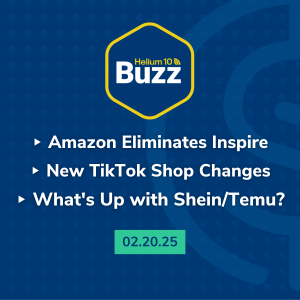
Thursday Feb 20, 2025
Thursday Feb 20, 2025
Amazon shutting down its TikTok-like shopping feed, TikTok shop beginning its global expansion, and what is up with Shein and Temu? More buzzing news stories in this episode!
► Instagram: instagram.com/serioussellerspodcast
► Free Amazon Seller Chrome Extension: https://h10.me/extension
► Sign Up For Helium 10: https://h10.me/signup (Use SSP10 To Save 10% For Life)
► Learn How To Sell on Amazon: https://h10.me/ft
► Watch The Podcasts On Youtube: youtube.com/@Helium10/videos
We’re back with another episode of the Weekly Buzz with Helium 10’s Senior Brand Evangelist, Shivali Patel. Every week, we cover the latest breaking news in the Amazon, Walmart, TikTok Shop, and E-commerce space, talk about Helium 10’s newest features, and provide a training tip for the week for serious sellers of any level.
Amazon kills ‘Inspire,’ its TikTok-style feed for discovering products
https://techcrunch.com/2025/02/18/amazon-kills-inspire-its-tiktok-style-feed-for-discovering-products/
TikTok Shop expands to Europe, Japan, Brazil
https://www.techinasia.com/news/tiktok-shop-expands-to-europe-japan-brazil
TikTok Shop surpasses Shein, Temu in US sales growth
https://www.techinasia.com/news/tiktok-shop-surpasses-shein-temu-in-us-sales-growth
BillingPlatform Teams With Quickbase to Automate Revenue Management
https://www.pymnts.com/partnerships/2025/billingplatform-teams-with-quickbase-to-automate-revenue-management/
TikTok Looks To Promote Livestream Shopping in More Regions
https://www.socialmediatoday.com/news/tiktok-live-stream-shopping-push-brazil-japan/740389/
In our final segment, we unlock the secrets of keyword research to supercharge sales spikes. By analyzing seasonal and year-round product trends, we reveal strategies using Helium 10's powerful features, such as historical trend analysis and reverse ASIN searches. Learn how to harness these insights for a competitive edge, ensuring your products thrive in both peak and lull sales periods. As we conclude, we highlight the latest updates to Helium 10's Magnet tool, designed to elevate your Amazon business strategy as an essential step forward in the ever-evolving e-commerce world.
In this episode of the Weekly Buzz by Helium 10, Bradley covers:
- 00:46 - Amazon Kills Inspire
- 03:28 - TikTok Shop Expands
- 05:07 - TikTok Beats Temu
- 06:52 - Shein, Temu Shift
- 08:41 - TikTok Live Surges
- 09:39 - Follow Helium 10 On TikTok
- 10:38 - Helium 10 New Feature Alerts
- 14:56 - Training Tip: How to Check an Amazon Product’s Organic and Sponsored Rank History
Enjoy this episode? Be sure to check out our previous episodes for even more content to propel you to Amazon FBA Seller success! And don’t forget to “Like” our Facebook page and subscribe to the podcast on iTunes, Spotify, or wherever you listen to our podcast.
Get snippets from all episodes by following us on Instagram at @SeriousSellersPodcast
Want to absolutely start crushing it on Amazon? Here are few carefully curated resources to get you started:
- Freedom Ticket: Taught by Amazon thought leader Kevin King, get A-Z Amazon strategies and techniques for establishing and solidifying your business.
- Helium 10: 30+ software tools to boost your entire sales pipeline from product research to customer communication and Amazon refund automation. Make running a successful Amazon or Walmart business easier with better data and insights. See what our customers have to say.
- Helium 10 Chrome Extension: Verify your Amazon product idea and validate how lucrative it can be with over a dozen data metrics and profitability estimation.
SellerTrademarks.com: Trademarks are vital for protecting your Amazon brand from hijackers, and sellertrademarks.com provides a streamlined process for helping you get one.
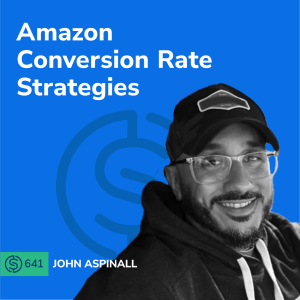
Tuesday Feb 18, 2025
#641 - Amazon Conversion Rate Strategies
Tuesday Feb 18, 2025
Tuesday Feb 18, 2025
In this episode, we unlock shopper insights to help you master your click-through rate strategy, grab attention, boost clicks, stop the scroll, and stand out on Amazon.
► Instagram: instagram.com/serioussellerspodcast
► Free Amazon Seller Chrome Extension: https://h10.me/extension
► Sign Up For Helium 10: https://h10.me/signup (Use SSP10 To Save 10% For Life)
► Learn How To Sell on Amazon: https://h10.me/ft
► Watch The Podcasts On YouTube: youtube.com/@Helium10/videos
Ever wondered how to make your Amazon listings more irresistible to shoppers? Join us as we welcome John Aspinall from PickFu, who spills industry secrets on optimizing listings for maximum click-through rates. Learn how compelling imagery and strategic elements can capture attention on Amazon’s bustling search results page. John provides valuable insights into the visual dynamics of competitive categories like supplements, guiding sellers on how to stand out amidst different SERP layouts and leveraging these insights for a marketplace edge.
But getting the click is just the beginning—converting that interest into a sale is the real challenge. Discover the art of crafting product detail pages that communicate essential information succinctly, especially for products like supplements. John and I dissect the importance of using real images over illustrations and how to harness "dead pixel real estate" on packaging to convey key benefits. From hero images that grab attention to tailoring strategies for various product categories, we explore the nuances of engaging potential buyers and boosting click-through rates.
Visual appeal can make or break a sale on Amazon, and we explore how packaging design can influence consumer behavior. John sheds light on how subtle differences in color and design can tip the scales between commoditized products and unique offerings. Learn how professional color choices can sometimes outshine cheaper, brighter options, and why clear, easy-to-read packaging is vital for a successful shopping experience. By addressing customer pain points and presenting relatable scenarios, we guide you in crafting a foolproof product detail page that enhances conversions and resonates with your target audience.
In episode 641 of the Serious Sellers Podcast, Shivali, Kevin, and John discuss:
- 00:00 - Optimizing Amazon Listings for Better Click-Through Rate
- 02:15 - Brand Influence on Consumer Decision Making
- 07:00 - Optimizing Product Listings for Conversions
- 07:49 - Enhancing Product Detail Page Engagement
- 13:47 - Alt Text and Brand Story Module
- 17:29 - Amazon Merchandising and CTR Strategy
- 20:59 - Visual Packaging Increases Sales
- 23:47 - Maximizing Amazon Brand Ad Clicks
- 30:37 - Enhancing Product Listings With Creative Merchandising
- 33:44 - Optimizing Product Listings for Higher Conversion
- 34:38 - Improve Product Detail Pages for Conversions
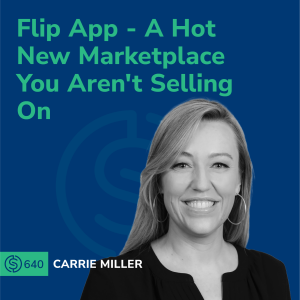
Saturday Feb 15, 2025
#640 - Flip App - A Hot New Marketplace You Aren't Selling On
Saturday Feb 15, 2025
Saturday Feb 15, 2025
In this episode, Carrie Miller reveals a new secret marketplace where she sells 30 units daily and shares powerful health hacks that kept her feeling her best for 3 years.
► Instagram: instagram.com/serioussellerspodcast
► Free Amazon Seller Chrome Extension: https://h10.me/extension
► Sign Up For Helium 10: https://h10.me/signup (Use SSP10 To Save 10% For Life)
► Learn How To Sell on Amazon: https://h10.me/ft
► Watch The Podcasts On YouTube: youtube.com/@Helium10/videos
Join us as we welcome Carrie Miller, Principal Brand Evangelist at Helium 10, back to the show, where she shares her exciting journey navigating the e-commerce landscape. Carrie has been thriving on a lesser-known platform called Flip, selling an impressive 30 units daily. She talks about her strategic approaches, including leveraging product inserts to collect customer emails, which has significantly boosted her Shopify sales. Additionally, Carrie shares insights into her ongoing ventures on Amazon with two family brands and her exploration of TikTok Shop, while addressing the challenges she faced with Walmart listings and her plans for improvement.
Explore the world of e-commerce with us as we discuss the rising trend of social media platforms becoming major shopping hubs. We talk about a popular new app that's capturing the attention of sellers and influencers alike. The app allows anyone to earn commissions by creating product-related videos, providing exposure and sales despite daily unpredictability. The conversation touches on the potential shift of influencers to this platform due to TikTok bans, and the exciting opportunities this presents for sellers seeking to diversify their strategies.
Listen in as we analyze the complexities of manufacturing and logistics within e-commerce, focusing on Carrie's decision to move to a closer 3PL in Reno for enhanced inventory flexibility. We discuss the challenges of transitioning into a Flip influencer and the potential for earning extra income through creative content. The conversation also highlights Carrie's experience with manufacturing decisions, from Turkey to future plans in the U.S., and the strategic use of Helium 10 tools to optimize product listings and maintain a competitive edge. Finally, we touch on health hacks with the powerful benefits of black seed oil and the latest features of Helium 10 that aid sellers in maximizing their marketplace success.
In episode 640 of the Serious Sellers Podcast, Bradley and Carrie discuss:
- 00:00 - New Marketplace Success and Health Hacks
- 02:28 - Warehouse Logistics Flexibility and Accessibility
- 05:16 - Introduction to Flip Platform for Sellers
- 06:41 - E-Commerce Success Strategies
- 08:58 - Social Media Platform Migration and Influencers
- 14:58 - Manufacturing and E-Commerce Strategy Analysis
- 15:47 - Making Money Through Social Media Platforms
- 22:14 - Strategies for Keyword Analysis and Advertising
- 26:07 - Navigating Amazon-Selling Challenges and Strategies
- 29:35 - Carrie's Health Hacks
- 30:23 - Favorite Helium 10 Features Discussion
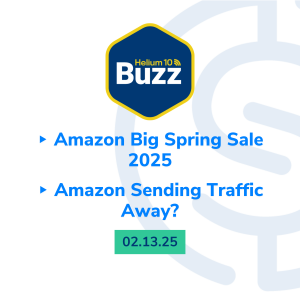
Thursday Feb 13, 2025
Helium 10 Buzz 2/13/25: Amazon Big Spring Sale 2025 | Amazon Sending Traffic Away?
Thursday Feb 13, 2025
Thursday Feb 13, 2025
Amazon announces its second-ever big spring sale. TikTok shop is opening in Mexico this week. Amazon is actually sending traffic off the platform. These buzzing stories and more in this episode!
► Instagram: instagram.com/serioussellerspodcast
► Free Amazon Seller Chrome Extension: https://h10.me/extension
► Sign Up For Helium 10: https://h10.me/signup (Use SSP10 To Save 10% For Life)
► Learn How To Sell on Amazon: https://h10.me/ft
► Watch The Podcasts On YouTube: youtube.com/@Helium10/videos
We’re back with another episode of the Weekly Buzz with Helium 10’s VP of Education and Strategy, Bradley Sutton. Every week, we cover the latest breaking news in the Amazon, Walmart, and E-commerce space, talk about Helium 10’s newest features, and provide a training tip for the week for serious sellers of any level.
Submit your deals and Prime-exclusive discounts for the Big Spring Sale
https://sellercentral.amazon.com/seller-news/articles/QVRWUERLSUtYMERFUiNHNkwyM0xXSDRFOURZM0RL
TikTok Expands In-Stream Shopping Push to Latin America
https://www.socialmediatoday.com/news/tiktok-shops-expansion-mexico-latin-america/739717/
Helping customers discover even more selection on Amazon
https://www.aboutamazon.com/news/retail/search-products-amazon-shopping-feature
Automatic minimum thresholds for order handling capacity
https://sellercentral.amazon.com/seller-news/articles/QVRWUERLSUtYMERFUiNHVDlDMlEzTTJTTlFNWUtE
And don't miss out on quick updates through the Serious Sellers Podcast Instagram, where we share more bite-sized content. Helium 10 New Feature Alerts talks about Helium 10’s new Listing Converter for TikTok Shop. Now available for Helium 10 Elite members. Lastly, understanding the intricacies of Amazon's recommended rank can be a game-changer for your product visibility and sales. We've got real-life examples of how correcting irrelevant keyword associations can enhance PPC impressions, using tools like Helium 10's Cerebro for effective keyword optimization. For niche markets, such as coffin and Gothic-themed products, learn how to use data insights to improve your marketing strategy while maintaining a balance between business growth and personal well-being. Join us to unlock the full potential of these e-commerce strategies!
In this episode of the Weekly Buzz by Helium 10, Bradley covers:
- 01:13 - Amazon Big Spring Sale
- 02:45 - TikTok Shop Mexico
- 03:48 - Amazon Sending Customers Off Platform
- 06:36 - FBM Order Capacity
- 08:48 - Follow Bradley on Instagram
- 09:43 - Helium 10 New Feature Alerts - Listing Converter for TikTok Shop
- 10:05 - Join Helium 10 Elite
- 12:49 - Training Tip: Amazon Recommended Rank
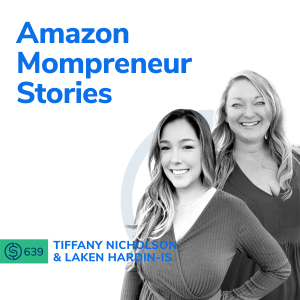
Tuesday Feb 11, 2025
#639 - Amazon Mompreneur Stories
Tuesday Feb 11, 2025
Tuesday Feb 11, 2025
In this episode, we've got a couple of first-time guests. They started selling on Amazon in the last couple of years and are part of a community where thousands of moms have come together to learn how to sell online.
► Instagram: instagram.com/serioussellerspodcast
► Free Amazon Seller Chrome Extension: https://h10.me/extension
► Sign Up For Helium 10: https://h10.me/signup (Use SSP10 To Save 10% For Life)
► Learn How To Sell on Amazon: https://h10.me/ft
► Watch The Podcasts On YouTube: youtube.com/@Helium10/videos
Join us for an exciting episode where we introduce two inspiring first-time guests, Laken Hardin-Is and Tiffany Nicholson, who have embarked on their e-commerce journeys with a community of entrepreneurial moms. Laken, an art major and graphic design enthusiast from South Carolina, shares her transition into the world of Amazon selling, blending her creative background with her newfound entrepreneurial spirit. Tiffany, from Akron, Ohio, narrates her path from communication studies and speech-language pathology to exploring e-commerce on Amazon. Both women discuss their unique paths and motivations, highlighting the blend of creativity and business acumen needed to succeed in the e-commerce world.
Listen in as we explore the process of building a brand from scratch, moving from retail arbitrage to establishing a private label brand. We talk about the initial hurdles of managing logistics and inventory and the breakthrough moments that came with the guidance of the Rainmaker family. Discover how tools like Helium 10 play a pivotal role in identifying product niches and opportunities. We also touch on the innovative strategies Laken and Tiffany employed to overcome challenges, such as product dimension issues, and how they now manage five SKUs with improved inventory systems, including the use of a 3PL in China. The conversation underscores the significance of brand building, social media presence, and leveraging customer insights to stay competitive.
This episode also highlights the importance of community and networking in the e-commerce industry, particularly for those entering a predominantly male space. The Amazon Influencer Program emerges as a potential entry point for generating additional income, utilizing everyday items to create engaging content. We discuss alternative avenues like Kindle Direct Publishing (KDP) and digital products for those seeking initial capital. Laken and Tiffany's experiences illustrate how community support and shared learning can accelerate success, providing invaluable encouragement and guidance along the way. Finally, they invite listeners to connect with us and the Rainmaker Family community to further explore these insights and follow the journeys of our guests.
In episode 639 of the Serious Sellers Podcast, Bradley, Laken, and Tiffany discuss:
- 00:00 - New Sellers Sharing Their Amazon-Selling Journeys
- 08:27 - Growing Sales Through Product Diversification
- 11:40 - Building a Brand is Important
- 17:09 - Product Research and Overcoming Competition
- 20:16 - Community Success in Amazon Selling
- 27:59 - Amazon Success Stories and Growth
- 31:04 - Connecting With Rainmaker Family Community
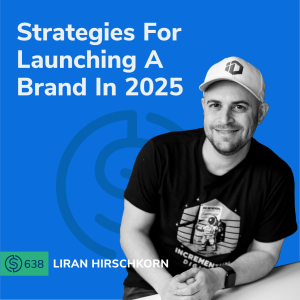
Saturday Feb 08, 2025
#638 - Strategies For Launching A Brand In 2025
Saturday Feb 08, 2025
Saturday Feb 08, 2025
In this episode, we're bringing back one of the first-ever guests on SSP from 2018. He'll discuss a wide range of topics, such as AMC, TikTok shop, influencer marketing, and more.
► Instagram: instagram.com/serioussellerspodcast
► Free Amazon Seller Chrome Extension: https://h10.me/extension
► Sign Up For Helium 10: https://h10.me/signup (Use SSP10 To Save 10% For Life)
► Learn How To Sell on Amazon: https://h10.me/ft
► Watch The Podcasts On YouTube: youtube.com/@Helium10/videos
Can understanding the latest trends in Amazon ads and influencer marketing transform your Amazon-selling and brand-launching strategy in 2025? Join us as we welcome back Liran Hirshkorn, CEO and Founder of Incrementum Digital, one of our earliest guests, who brings his expert insights into the rapidly evolving world of Amazon selling. This year marks a transformative period for platforms like Amazon, where changes in fees and advertising dynamics have forced sellers to realign their focus toward profitability. Liran shares compelling strategies for navigating these shifts and highlights the innovative use of Amazon AI search, Rufus, which is personalizing shopping experiences by customizing search results based on individual habits.
Explore the power of enhanced data visibility in Amazon advertising and uncover the secrets to optimizing your strategies. In this episode, we unravel how understanding the customer journey through expanded data insights can significantly boost purchase rates and ad efficiency. Discover how Amazon's strategic expansion beyond its own marketplace opens new avenues for sellers familiar with its advertising platform, allowing them to broaden their reach across different channels. Liran’s insights into leveraging Amazon Marketing Cloud to create lookalike audiences for more targeted advertising are not to be missed.
Finally, we navigate the dynamic relationship between TikTok and major retail giants like Amazon and Walmart. Hear the captivating story of a seller's transition from Amazon to TikTok, illustrating the platform's impact in driving demand through engaging content and viral potential. We discuss how TikTok's algorithm enhances product discovery, especially for visually appealing items, and the implications of strategic partnerships that could reshape the e-commerce landscape. Throughout this episode, we emphasize the importance of building a strong brand identity and utilizing diverse marketing channels to stand out in today's competitive market. Tune in for a plethora of insights that promise to redefine your approach to e-commerce success.
In episode 638 of the Serious Sellers Podcast, Bradley and Liran discuss:
- 00:00 - E-Commerce Trends and Strategies for 2025
- 01:29 - Amazon PPC Changes and Current Challenges
- 03:54 - Personalized AI Shopping Experiences
- 11:00 - Shift in Search Results and Analytics
- 11:46 - Amazon Advertising Trends and Strategies
- 14:32 - Amazon Advertising's Expansion Into Other Retailers
- 17:59 - Advanced E-Commerce Strategies and Influencers
- 21:52 - Influencer Marketing's Impact on Brand Launches
- 27:57 - TikTok and Amazon Integration Strategy
- 29:57 - Beauty Product's Success on TikTok
- 36:04 - Amazon Sales Boosting Strategies
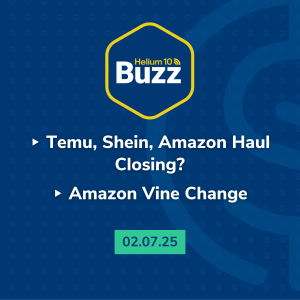
Friday Feb 07, 2025
Friday Feb 07, 2025
Is this the end for Temu, Shein, & Amazon Haul? Secret Amazon pilot programs hint at big changes. Plus, Amazon may edit your listings next week! All these buzzing stories on today’s episode!
► Instagram: instagram.com/serioussellerspodcast
► Free Amazon Seller Chrome Extension: https://h10.me/extension
► Sign Up For Helium 10: https://h10.me/signup (Use SSP10 To Save 10% For Life)
► Learn How To Sell on Amazon: https://h10.me/ft
► Watch The Podcasts On YouTube: youtube.com/@Helium10/videos.
We’re back with another episode of the Weekly Buzz with Helium 10’s VP of Education and Strategy, Bradley Sutton. Every week, we cover the latest breaking news in the Amazon, Walmart, and E-commerce space, talk about Helium 10’s newest features, and provide a training tip for the week for serious sellers of any level.
Shein, Temu, Amazon Haul set for price hikes as US shuts trade loophole
https://www.reuters.com/business/retail-consumer/shein-temu-amazon-haul-set-price-hikes-us-shuts-trade-loophole-2025-02-04/
What New U.S. Policies on Imports From China Mean for Shein and Temu
https://time.com/7212903/shein-temu-usps-china-hong-kong-tariffs-trump/
Secret Amazon Pilot Programs
Apollo pilot program
https://sellercentral.amazon.com/help/hub/reference/GA263VSD6RXPYBMC
StockSmart pilot program
https://sellercentral.amazon.com/help/hub/reference/GLQWZVYJH5K6X6HE
Review Amazon Listing Updates
https://sellercentral.amazon.com/selectiongaps/review-listing-updates
Upgrade to a higher Amazon Vine enrollment tier within first 30 days
https://sellercentral.amazon.com/seller-news/articles/QVRWUERLSUtYMERFUiNHS1RVRVNCQjlVTFc2NjNE
Amazon Prime members enjoyed fastest-ever delivery speeds in 2024
https://www.aboutamazon.eu/news/retail/amazon-prime-members-enjoyed-fastest-ever-delivery-speeds-in-2024
Amazon Prime members enjoyed fastest-ever delivery speeds in 2024, and US members saved on average over $500 on delivery fees
https://www.aboutamazon.com/news/retail/prime-members-us-savings-fastest-delivery-2024
Amazon announces February product event
The long-delayed smarter version of Amazon’s Alexa could launch at the event this month.
https://www.theverge.com/news/606622/amazon-february-event-announced-alexa
Create bulk listings with your own template format
https://sellercentral.amazon.com/seller-news/articles/QVRWUERLSUtYMERFUiNHUE5BQjlFQ1A1NENDWkVY
We wrap up with exciting updates on resources like the Amazon Influencer Bootcamp inside Helium 10’s Freedom Ticket course to help Amazon influencers maximize their success. This week's strategy highlights Helium 10's Black Box feature for Amazon Brand Analytics, see verified sales by keywords over weeks or months, not just estimates but verified sales numbers for any product or group of products. Whether you're a seasoned seller or just starting out, this episode is packed with insights and strategies to help you navigate the rapidly changing world of Amazon and the e-commerce world.
In this episode of the Weekly Buzz by Helium 10, Bradley covers:
- 01:15 - Temu, Shein, Amazon Haul Dead?
- 07:50 - Secret Amazon Pilot Programs
- 17:31 - Amazon Changing Listings
- 19:15 - Amazon Vine Change
- 20:13 - 2024 Prime Delivery Stats
- 21:48 - Amazon Alexa Update
- 23:01 - Bulk Listing Update
- 23:35 - IDR For EU and JP
- 24:30 - Helium 10 New Feature Alerts
- 26:11 - Training Tip: Helium 10 Black Box x Amazon Brand Analytics Strategy
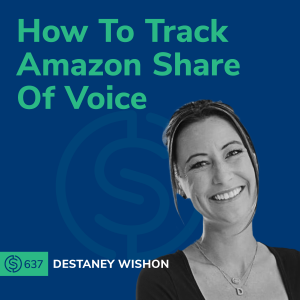
Tuesday Feb 04, 2025
#637 - How To Track Amazon Share Of Voice
Tuesday Feb 04, 2025
Tuesday Feb 04, 2025
In this TACoS Tuesday episode, Bradley and Destaney Wishon discuss different Amazon advertising strategies, campaign types, how to measure Share of Voice, and more.
► Instagram: instagram.com/serioussellerspodcast
► Free Amazon Seller Chrome Extension: https://h10.me/extension
► Sign Up For Helium 10: https://h10.me/signup (Use SSP10 To Save 10% For Life)
► Learn How To Sell on Amazon: https://h10.me/ft
► Watch The Podcasts On YouTube: youtube.com/@Helium10/videos
Join us for an enlightening TACoS Tuesday discussion on Amazon Advertising Strategies for Success with our expert guest, Destaney Wishon, CEO at BTR Media. Together, we explore advanced techniques to elevate your advertising game on Amazon. We unpack essential tools like the Amazon Marketing Cloud (AMC) and Demand-Side Platform (DSP), as well as campaign segmentation strategies. We also highlight the significance of understanding the time gap between clicks and purchases, shedding light on common misconceptions about dayparting Amazon ads. With insights from Amazon Marketing Stream data, we provide actionable strategies to optimize your advertising efforts, ensuring you can effectively apply these techniques to your business.
As we move forward, we focus on maximizing Amazon ad type expansion, emphasizing the competitive edge gained by utilizing unique ad formats such as sponsored brand and display ads. Destaney shares insights into the effectiveness and costs associated with sponsored brand videos, particularly on mobile platforms. We also address audience experiences with video ad performance, clarify targeting options, and explore the potential overlap in ad real estate. Our conversation also covers optimizing these ad types for conversions, offering strategies to combine various ad formats for enhanced conversion rates and discussing creative content's role in driving success.
Finally, we highlight the importance of understanding Share of Voice on Amazon, a crucial metric for both large and small brands. We discuss how tools like Helium 10’s Share of Voice tool can provide valuable insights into brand positioning relative to competitors, helping inform strategic investment decisions. We explore organic versus paid presence and the impact of owning more "real estate" on Amazon's search pages. Our session wraps up with an overview of best practices for utilizing brand metrics and share of voice tools, offering guidance on campaign management, bid strategies, and maximizing profitability. Don't miss this opportunity to refine your Amazon PPC strategies with insights from our engaging conversation with Destaney.
In episode 637 of the Serious Sellers Podcast, Bradley and Destaney discuss:
- 00:00 - Amazon Advertising Strategies for Success
- 02:22 - Timing Discrepancy Between Clicks and Purchases - Dayparting
- 05:54 - Optimizing Bid and Budget Strategies
- 09:16 - Maximizing Amazon Ad Type Expansion
- 12:20 - Comparing Amazon Sponsored Brand Ad Performance
- 13:30 - Amazon Sponsored Products Conversion Analysis
- 18:35 - Optimizing Amazon Ad Types for Conversions
- 26:56 - Optimizing Bid Management Strategy for Campaigns
- 29:52 - Understanding Share of Voice on Amazon
- 31:57 - Optimizing Amazon Advertising Through Keywords
- 35:33 - Importance of Amazon Rank Strategy
- 36:24 - Amazon PPC Best Practices Overview
- 40:17 - Fixed Bids vs Other Bid Types